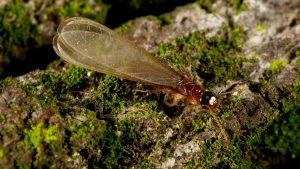For the first time, a tropical invasive termite species was reported swarming beyond its expected range in Florida. A team of termite scientists at the University of Florida has confirmed heightened invasive subterranean termite activity in Tampa, indicating these termites are spreading across the state.
The researchers are most concerned about the abundance of invasive Asian subterranean termite specimens that Hillsborough County pest control operators have submitted for identification since the start of March.
“This invasive subterranean termite species is known not only to be an important structural pest, but it can also critically harm the urban tree canopy, as colonies typically infest and hollow large healthy trees,” said Thomas Chouvenc, an assistant professor of urban entomology at the UF/IFAS Fort Lauderdale Research and Education Center, who leads the team’s research effort on Asians subterranean termite.
The team confirmed the Asian subterranean termites, known by their scientific name as Coptotermes gestroi, are now established in South Tampa. Pest control operators using the Termite ID service provided by UF/IFAS led to the initial detection.
Researchers suspect the initial infestation may have occurred seven to 10 years ago, and now Asian subterranean termite activity is increasing in the Tampa area and has finally been detected.
“The Tampa invasion is now the most northern point of infestation of this tropical species in the state, implying that other cities on the Florida west coast, south of Tampa, are potentially at risk for this species to establish in the coming years, if not already established, but not yet detected,” said Chouvenc.
Often labeled as the “tropical cousin” to the Formosan subterranean termite, the Asian subterranean termite species is similar in biology and is increasingly contributing toward the billions of dollars in structural damage each year by termites. The difference between the two species lies in where they establish. Until now, the Asian subterranean termite has reportedly restricted itself to tropical climates, while the Formosan species is widespread throughout the Southeastern U.S.

In the past four decades, the Formosan subterranean termite has spread and increased the potential risk for termite damage throughout most of Florida’s major cities from Miami to Jacksonville to the Panhandle. In comparison, the Asian subterranean termite was first detected in the late 1990s in Miami and has spread in four southeast Florida cities, including Riviera Beach, Fort Lauderdale, Miami and Key West.
“The Asian subterranean termite has thus far been restricted to Southeast Florida because of its tropical climate requirement,” said Chouvenc. “This species has been reported to infest boats easily and has been intercepted in many private boats throughout the Florida coast, including St. Petersburg, Fort Myers and Naples.”
In the termite life cycle, a mature colony of millions of termites can produce winged termites seasonally. These winged termites can fly among large swarms, find a potential mate and become the queen and king of new colonies.
“When winged termites fly out of an infested docked boat, they can start colonies on the land in the nearby area, and if the climate is appropriate, they can establish and are now part of the local ecosystem,” said Chouvenc.
Asian subterranean termites are typically first detected in trees, where the colonies begin forming. Mud tubes on trees are signs of termite colony activity. These tubes, made from soil and wood combined with termite saliva, connect the termite colonies to tunnels in the soil to their above-ground food sources.
Researchers recommend regular tree inspections for termite activity to promote early detection in areas where termite infestations are confirmed.
“Conducting intensive tree inspection efforts in the known infested areas would slow down the spread of this invasive termite species in this area, save many trees and prevent costly damages to structures,” said Chouvenc.
Meanwhile, using above-ground baits can eliminate active colonies rapidly before damage to trees become problematic and before the colonies expand their feeding toward nearby structures such as homes, said Chouvenc.
###
ABOUT UF/IFAS
The mission of the University of Florida Institute of Food and Agricultural Sciences (UF/IFAS) is to develop knowledge relevant to agricultural, human and natural resources and to make that knowledge available to sustain and enhance the quality of human life. With more than a dozen research facilities, 67 county Extension offices, and award-winning students and faculty in the UF College of Agricultural and Life Sciences, UF/IFAS brings science-based solutions to the state’s agricultural and natural resources industries, and all Florida residents.
Para accesar a esta comunicación en español, por favor utilice este enlace.
 4
4
